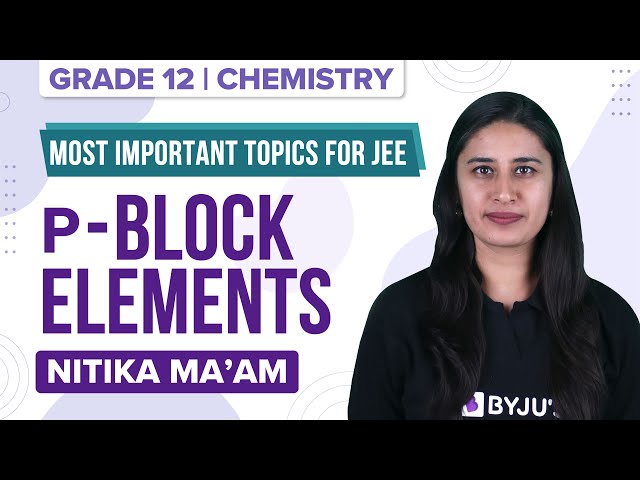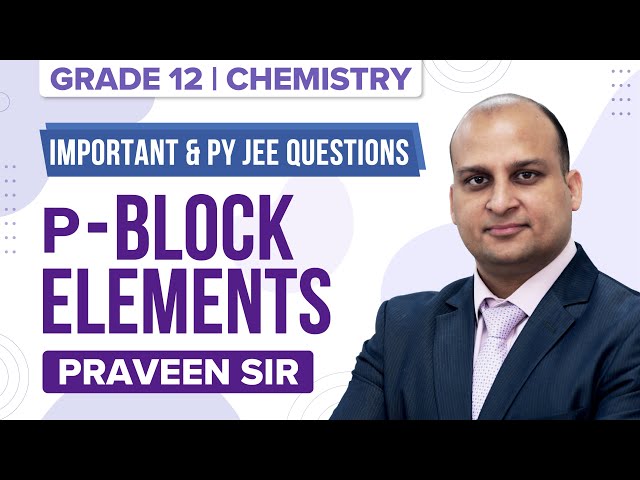P Block Previous Year Questions with Solutions are given here. P block elements are the elements in which the last electron enters in any of the three p-orbitals of their respective shells. Since a p-subshell has three degenerate p-orbitals each of which can accommodate two electrons, therefore in all there are six groups of p-block elements. The p-block elements are found on the right side of the periodic table. Elements in the p block of periodic table include metals, non-metals and metalloids.
P block elements are good conductors of electricity and heat since they have a tendency to lose an electron. These elements consist of elements from the 13th group to 18th group in the periodic table. BYJU’S provides accurate solutions prepared by our subject matter experts. Students can easily download these solutions in PDF format for free.
Download p-Block Previous Year Solved Questions PDF
JEE Main Past Year Solved Questions on P Block
1. From the following statements regarding H2O2, choose the incorrect statement :
(1) It has to be stored in plastic or wax-lined glass bottles in the dark
(2) It has to be kept away from dust
(3) It can act only as an oxidizing agent
(4) It decomposes on exposure to light
Solution:
Na2SO3 + H2O2 → Na2SO4 + H2O
Hydrogen peroxide can act as both oxidising and reducing agent.
Hence option (3) is the answer.
2. The compound that does not produce nitrogen gas by the thermal decomposition is
(1) (NH4)2Cr2O7
(2) NH4NO7
(3) (NH4)2SO4
(4) Ba(N3)2
Solution:
(NH4)2SO4 → 2NH3 + H2SO4
On thermal decomposition of (NH4)2SO4, NH3 is evolved. On thermal decomposition of the other given compounds, N2 is evolved.
Hence option (3) is the answer.
3. Glass is a
(1) micro-crystalline solid
(2) super-cooled liquid
(3) gel
(4) polymeric mixture.
Solution:
Glass is a transparent or translucent amorphous supercooled solid solution (supercooled liquid) of silicates and borates.
Hence option (2) is the answer.
4. Which one has the highest boiling point?
(1) Kr
(2) Xe
(3) He
(4) Ne
Solution:
The boiling point increases down the group.
Hence Xe has the highest boiling point in the given elements.
Hence option (2) is the answer.
5. Which of the following are Lewis acids?
(1) AlCl3 and SiCl4
(2) PH3 and SiCl4
(3) BCl3 and AlCl3
(4) PH3 and BCl3
Solution:
Lewis acid is an electron pair acceptor.
Both BCl3 and AlCl3 have vacant p- orbital and thus incomplete octet.
Hence they will act as Lewis acid.
Hence option (3) is the answer.
6. Which one of the following depletes the ozone layer?
(1) NO and freons
(2) SO2
(3) CO
(4) CO2
Solution:
NO and freons deplete the ozone layer.
Hence option (1) is the answer.
7. Which one of the following reactions of Xenon compounds is not feasible?
(1) 2XeF2 + 2H2O → 2Xe +4HF +O2
(2) XeF6 + RbF → Rb[XeF7]
(3) XeO3 + 6HF → XeF6 + 3H2O
(4) 3XeF4 + 6H2O → 2Xe +XeO3 +12HF+1.5O2
Solution:
XeF6 + 3H2O → XeO3 + 6HF
XeF6 has more tendency to hydrolyse. So the reverse reaction occurs.
Hence option (3) is the answer.
8. Assertion: Among the carbon allotropes, diamond is an insulator, whereas, graphite is a good conductor of electricity.
Reason: Hybridization of carbon in diamond and graphite are sp3 and sp2, respectively.
(1) Both assertion and reason are correct, but the reason is not the correct explanation for the assertion.
(2) Both assertion and reason are correct, and the reason is the correct explanation for the assertion.
(3) Both assertion and reason are incorrect.
(4) Assertion is an incorrect statement, but the reason is correct.
Solution:
Diamond is a bad conductor of electricity due to the non-availability of free electrons. Graphite is a good conductor of electricity due to the fourth valence electron of each carbon which is free to move.
Hence option (1) is the answer.
9. Which of the following statements is wrong?
(1) Single N–N bond is weaker than the single P–P bond
(2) N2O4 has two resonance structures
(3) The stability of hydrides decreases from NH3 to BiH3 in group 15 of the periodic table
(4) Nitrogen cannot form d pi – p pi bond
Solution:
The stability of hydrides decreases from NH3 to BiH3 in group 15 of the periodic table.
Hence option (3) is the answer.
10. Boron cannot form which one of the following anions?
(1) B(OH)4–
(2) BO2–
(3) BF63-
(4) BH4–
Solution:
Because of the non-availability of d-orbitals, boron is unable to expand its octet. Hence the maximum covalence of boron cannot exceed 4.
Hence option (3) is the answer.
11. Which of the following statements regarding sulphur is incorrect?
(1) At 6000 the gas mainly consists of S2 molecules
(2) The oxidation state of sulphur is never less than +4 in its compounds
(3) S2 molecule is paramagnetic
(4) The vapour at 2000 C consists mostly of S8 rings
Solution:
The oxidation state of sulphur is +2, +4, +6 and -2.
Hence option (2) is the answer.
12. The amorphous form of silica is
(1) cristobalite
(2) kieselguhr
(3) tridymite
(4) quartz.
Solution:
Kieselguhr is the amorphous form of silica.
Hence option (2) is the answer.
13. The gas evolved on heating CaF2 and SiO2 with concentrated H2SO4, on hydrolysis gives a white gelatinous precipitate. The precipitate is:
(1) silica gel
(2) silicic acid
(3) hydrofluosilicic acid
(4) calcium fluorosilicate
Solution:
H2SO4 + CaF2 → CaSO4 + 2HF
4HF + SiO2 → SiF4 +2H2O
3SiF4 +2H2O → 2H2SiF6 + SiO2
Hydrofluosilicic acid is H2SiF6
Hence option (3) is the answer.
14. Example of a three-dimensional silicate is :
(1) Beryls
(2) Zeolites
(3) Feldspars
(4) Ultramarines
Solution:
Feldspars are an example of three-dimensional silicate.
Hence option (3) is the answer.
15. Chlorine water on standing loses its colour and forms:-
(1) HCl and HClO2
(2) HCl only
(3) HOCl and HOCl2
(4) HCl and HOCl
Solution:
Cl2 + H2O → HCl + HOCl
Hence option (4) is the answer.
16. What may be expected to happen when phosphine gas is mixed with chlorine gas?
(1) The mixture only cools down
(2) PCl3 and HCl are formed and the mixture warms up
(3) PCl5 and HCl are formed and the mixture cools down
(4) PH3·Cl2 is formed with warming up.
Solution:
PH3 + 4Cl2 → PCl5 + 3HCl
Phosphine gas when mixed with chlorine gas, gives phosphorus pentachloride and HCl.
Hence option (3) is the answer.
Also Read:
| JEE Advanced P Block Previous Year Questions with Solutions |
| Introduction to p-Block Elements |
| p-Block Elements |
p-Block Elements – Important Topics

p-Block Elements – Important Questions


Comments